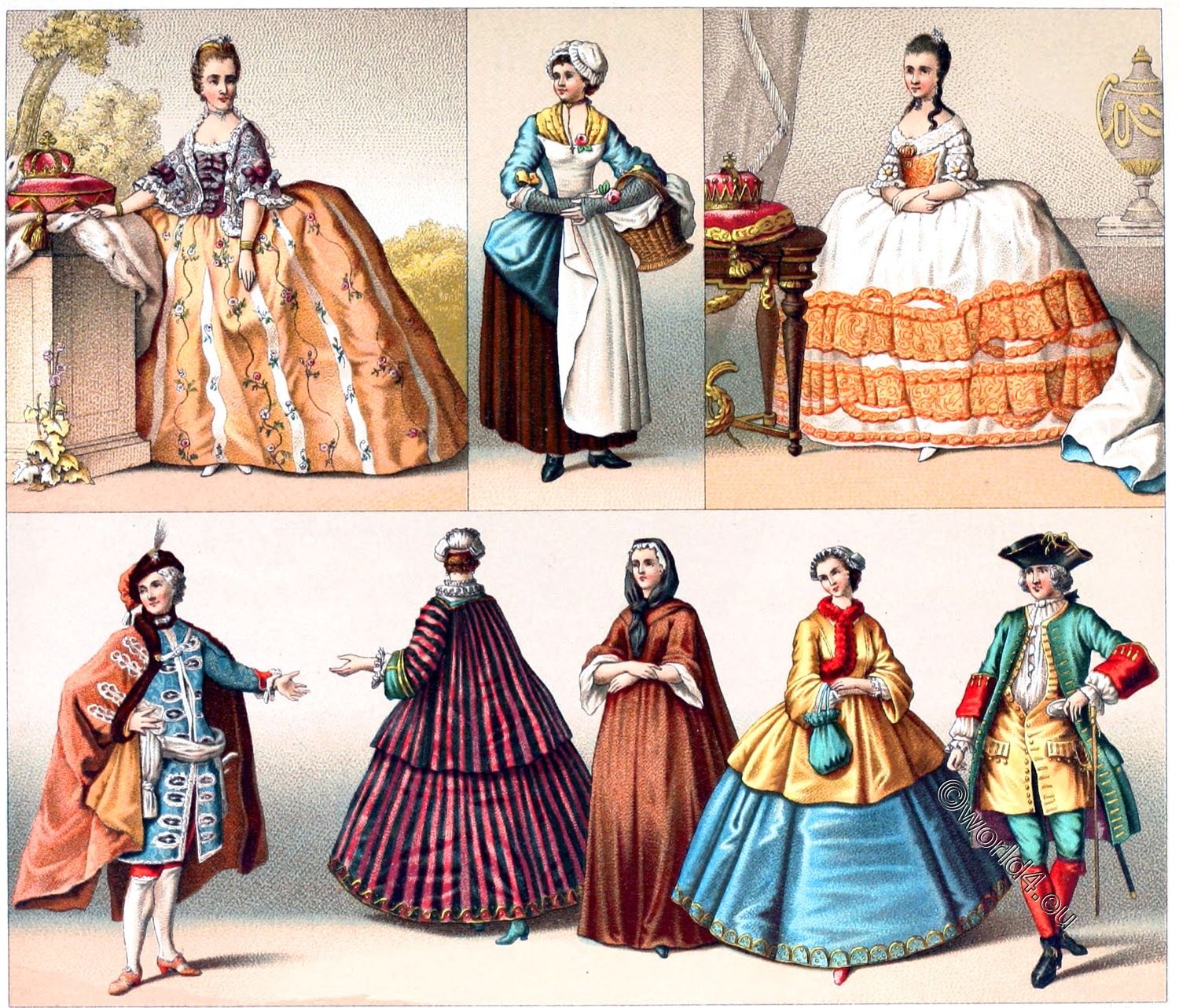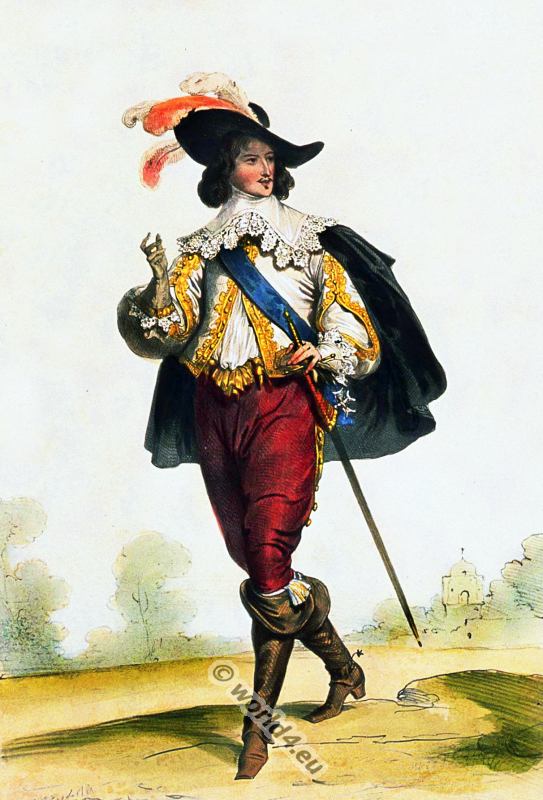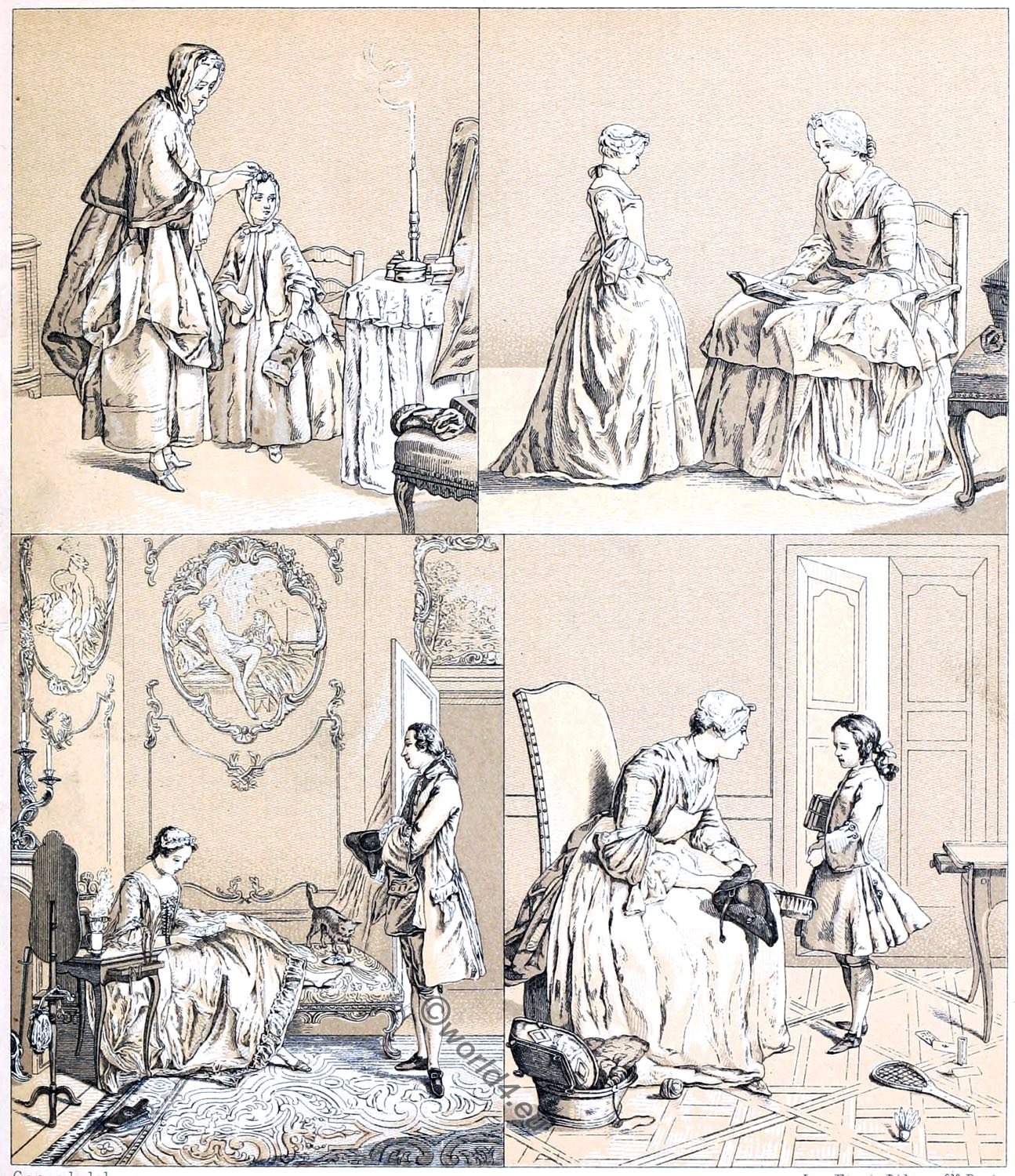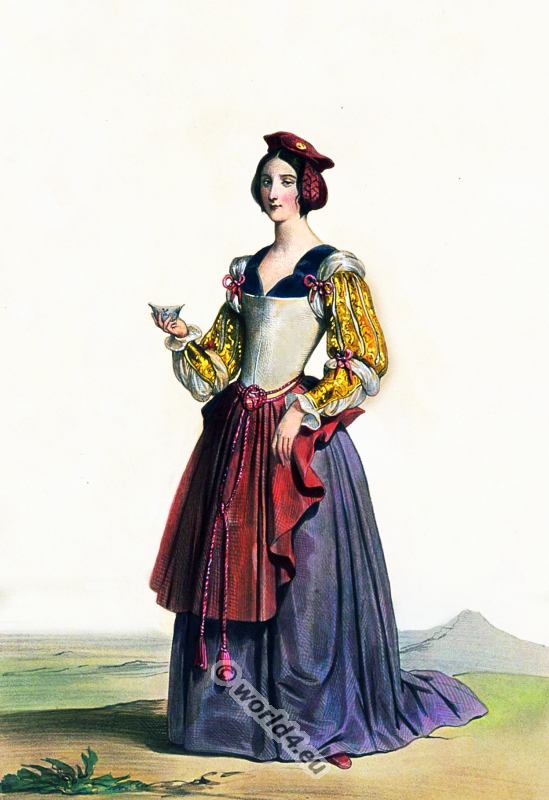
1 2 3
4 5 6 7 8
FRANCE. 18TH CENTURY. COSTUMES OF THE NOBILITY, THE BOURGEOISIE AND THE LOWER CLASSES UNDER LUDWIG XV. HISTORICAL FIGURES AND FASHION TYPES.
THE GASAQUIN.
No. 1. Marie Luise, Empress of Germany, wife of Leopold II, 18th century portrait in the Museum of Versailles *).
Low hair twirl with flat chignon covered by a muslin veil with tiara and agraffe; earrings; bracelets; lace tie; bodice decorated with bows, with open sleeves en éventail and double lace advance; breadier à coudes; wide robe with floral branches and wide stripes. Shoes with high heels.
No. 3. Maria Beatrice of Este, Duchess of Massa, wife of Archduke Ferdinand Portrait from the 18th century; Museum of Versailles **).
Low coiffure, raised above the forehead with crochets and dragonnes; agraffes, earrings, pearl necklace; lace collar on a bodice with the crown and coat of arms of the Archduke; sleeves en éventail with double cuffs and two large band rosettes; white satin robe with three stripes of gold brocade and long train.
No. 4. Ulrike Eleonore, Queen of Sweden, Sister of Charles XII.
Portrait from the XVIII. Century; Museum of Versailles. Male costume in Polish style; fur cap with agraffe; blue contour with braids and fur collar; white sash; Deliura, sleeveless coat; red waistcoat and trousers; white stockings and escarpins; crooked sabre.
No. 2. Countrywoman. Headgear is the dormeuse (sleeping or negligee bonnet) customary among the women of the people; apron skirt with short sleeves; underskirt of barchent; breast cloth, partially covered by the bib of the apron. Long fillet gloves.
The Casaquin, pet-en-l’air or Caraco.
A women’s garment from the late seventeenth and early eighteenth centuries, it was made of a petticoat bodice of linen decorated with silk, lace and embroidery, first worn undecorated by women from the common people or the country, over the skirt, and later adopted by the aristocracy. These jackets were often worn with a fichu (a triangular scarf) and combined with a petticoat or a fashionable skirt.
Nos. 5 and 7. Ladies in the Casaquin. The casaquin, pet-en-l’air or caraco is a variation of the casaque with wide laps. The pet-en-l’air is a long casaquin and is worn with the robe à la Française. It usually falls to the hips and has very wide Watteau pleats. These wrinkles moved uncontrolled in the wind and were name-giving translated as Little Poop that moves in the wind. This style was popular from the 1750s to 1770s.
No. 5. headdress, made of marli a kind of gauze; lace collar; casaquin falling over the robe.
No. 7. casaquin with a narrow waist; robe volante; palatine made of chenille; headdress made of marli; work pouch.
No. 6. Lady of the Commonwealth.
The headdress is covered by a mantilla tied under the chin; wide robe, fitting to the corset, but falling freely at the back and sides; sleeves en pagodes with lapels.
No. 8. man in ordinary dress (1730).
Gallant hat with bow; pouch wig; white tie; jabot and waist buttoned vest; wide skirt with sleeves en pagoda, red lapels and stiffened lapels; breeches; buckled shoes with wooden heels.
No. 2 from the series of engravings by Dupin: Costumes of the various classes of French society in the eighteenth century.
No. 6 from the continuation of the demonstrations of miracles performed at the intercession of M. de Paris, 1741.
No. 5, 7 and 8 from the Engelbrecht Collection.
Cf. Quicherat, Histoire du costume en France, and Paul Lacroix, le Dix-huitième siècle, Institutions, Usages et Costumes.

*) María Ludovica of Spain (Spanish: María Luisa de Borbón 1745-1792) was a daughter of Charles III of Spain (1716-1788) and Maria Amalia of Saxony (1724-1760). She was by birth an Infanta of Spain and as wife of Leopold II (1747-1792) from 1765 to 1792 Archduchess of Austria, from 1765 to 1790 Grand Duchess of Tuscany and from 1790 to 1792 Empress of the Holy Roman Empire and Queen of Bohemia, Croatia and Hungary.
**) Maria Beatrice Ricciarda d’Este (also Maria Beatrix von Este 1750-1829) from the house of Este was the last and sole heir of her famous family. Maria Beatrice Ricciarda d’Este was born in Modena on 7 April 1750 as the first child and only daughter of the Duke of Modena, Ercole III d’Este, and his wife Maria Teresa Cybo-Malaspina (a daughter of the Duke Alderano of Massa and Carrara).
When her younger brother Rinaldo, the heir to the House of Este, died in 1753, a few months after his birth, she became the sole heiress of the Duchy of Modena and the Duchy of Reggio due to the lack of male heirs. She also inherited the Duchies of Massa and Carrara from her mother. As heiress of four duchies, Maria Beatrice was a sought-after contestant on the European marriage market and attracted the attention of Empress Maria Theresa of Austria, who sought to establish advantageous dynastic relations between the House of Habsburg and Italian princely houses as part of her marriage plans.
Archduke Ferdinand Karl was therefore engaged to the only daughter of the Duke of Modena, Maria Beatrice, from an early age. Part of the wedding celebrations were the premieres of the operas Il Ruggiero by Johann Adolph Hasse and Ascanio in Alba (Festa teatrale in due atti) by Wolfgang Amadeus Mozart. The marriage between Ferdinand Karl and Maria Beatrice was a happy one.
Source: History of the costume in chronological development by Auguste Racinet. Edited by Adolf Rosenberg. Berlin 1888.
Related
Discover more from World4 Costume Culture History
Subscribe to get the latest posts sent to your email.







